July-August 2018
And Then...
Welcome to Africa: We Enter a Whole New World
It was a hot day, dry and dusty, as we drove along a rough dirt road to where a hide was indicated on our map. We were in a national park and the hide overlooked a water hole so even though it was approaching mid-day, we had hopes of seeing animals. It was a pretty spot, but all we saw were a few birds, a lizard and some turtles. Okay, no problem, we’ll drive on to the next spot…. AND THEN, while backing out, Rick suddenly saw elephants in the rearview mirrors — they were crossing the road behind us headed for the water hole. All at once our day had turned around and the heat and dryness and dust no longer mattered.
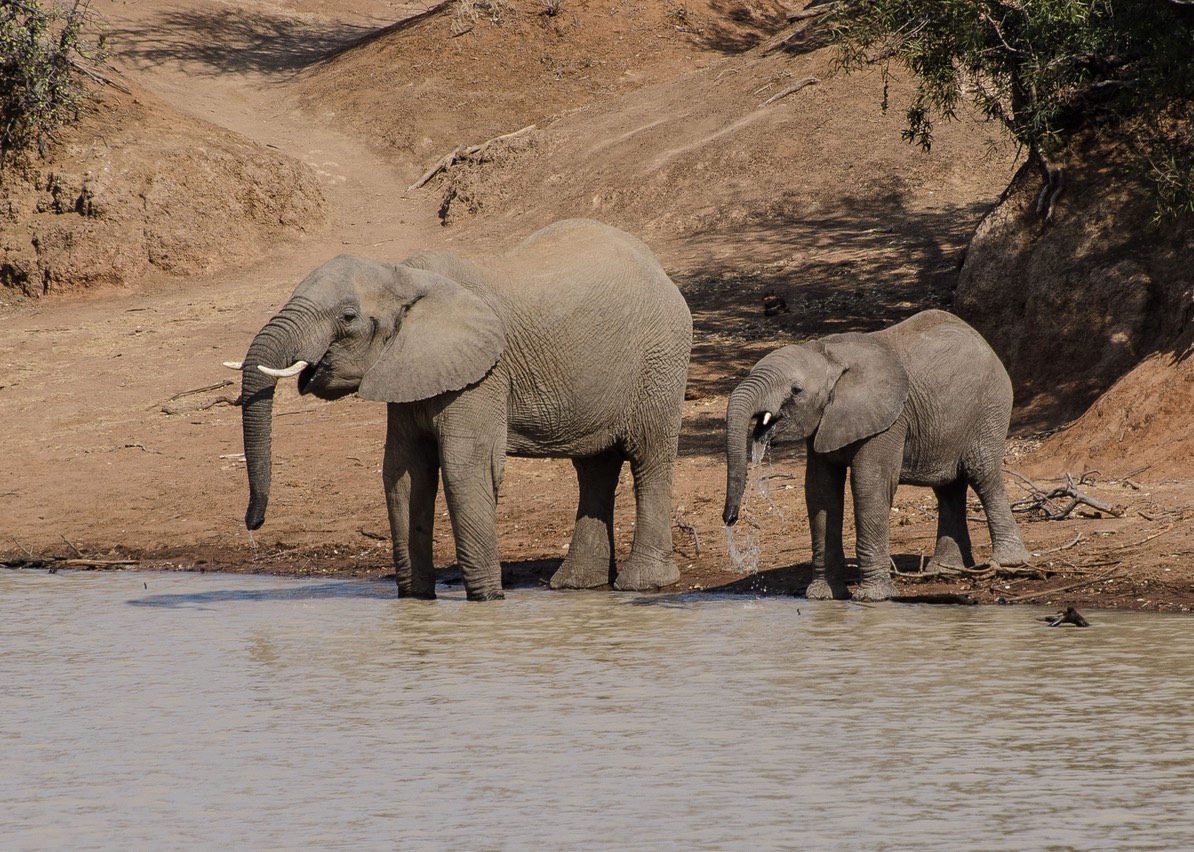
Welcome to Africa.
But that great experience was just a few days ago. We need to go back a month or so in order to tell you the whole story from the start…
After a fun but hectic six weeks’ visit back in the United States, we caught a Thursday night flight from Portland, Oregon, to Durban, South Africa, by way of New York and Dubai, Kathy muttering all the way that it would have been shorter had we flown to Africa across the Pacific instead of the Atlantic. But Emirates Air knew better and of course they’re right. After 32 hours of travel and a nine hour time change we arrived bedraggled but unbowed on a Saturday evening. The poor taxi driver who brought us in to our hotel had to struggle with luggage filled to the brim with clothing, cameras, electronic gear and spares for the Tiger, along with a couple of just slightly cranky Americans.
A couple of days in the very nice Bel-Aire Hotel along Durban’s famous coastline right on the Indian Ocean helped to put us right again. The hotel’s well known (and fabulous) breakfast buffet on the 11th floor with full view of the water certainly didn’t hurt, and neither did the fact that there were monkeys roaming freely in the shrubbery across the way, next to the beach. They were great fun to watch and a welcome reminder that we were in a new and very different place. Two lovely dinners in the hotel restaurant didn’t hurt either. We made a few short excursions out beyond the promenade, seeking ATMs and other odd bits, but spent most of our time starting to organize and plan for the months ahead.
We anticipate that we will stay in Africa for at least one year, perhaps two, and that’s a whole lot of planning! Several weeks later, we’re still trying to get our heads around it all. South Africa is different from other countries we’ve visited. We’ve always enjoyed doing tremendous amounts of wild camping — stopping for the night when we arrived at an interesting place, from near a town to out in the middle of nowhere. In this country, travelers are warned, strongly cautioned, that it isn’t safe to do that. As a result we find that we must plan our day around where we’ve determined that there will be a place to stay that night. This just isn’t our style, and is proving hard for us to adapt to, but we’re working on it.
On the Monday, we took a taxi to our shipping agent’s office, and collected the Tiger. That all sounds very simple and straightforward, right? Well, as always, there were a few details to get sorted, but the staff was terrific and within a couple of hours we were on our way. Ah yes, keep left, keep left. Why do all these countries insist upon driving on the wrong side of the road? The simple answer should be that they were settled by the British. But then, how do you account for Japan? Actually, after spending fifteen months driving in Australia and New Zealand we didn’t actually need very many reminders. It had been harder to stay on the right side of the road in the US.
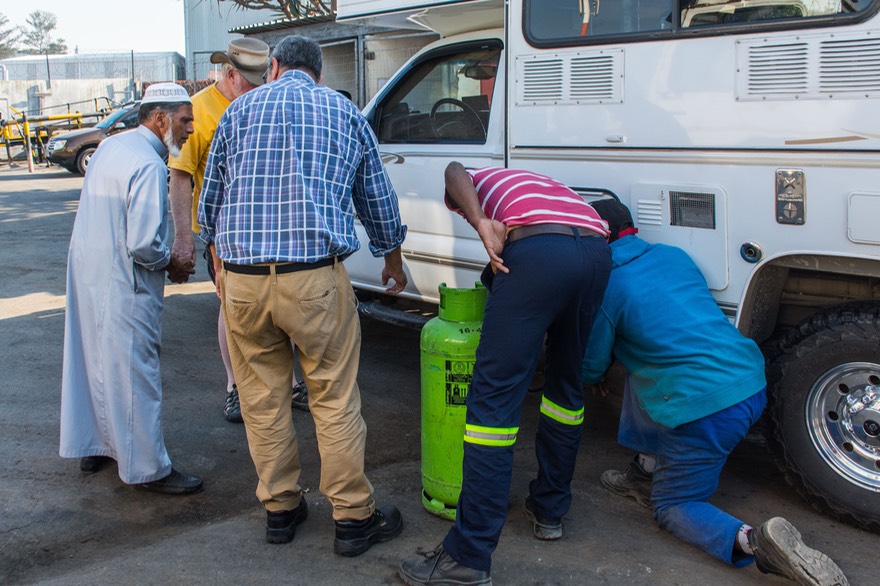
We immediately headed for a caravan holiday park in Queensbrough, a Durban suburb, where we settled in for a bit. We did grocery shopping; arranged to purchase a WildCard, which would entitle us to free entry at many of the South African national parks; worked on figuring out how to get propane; and began a lengthy attempt to have our existing wifi gizmo (purchased in Australia) unlocked so it could accept a South African SIM card and we could get internet. (Never happened, despite all assurances to the contrary. Finally we gave up and bought a local gizmo.)
These various chores allowed (forced?) us to explore the outskirts of Durban, SA’s second largest city (the Cape Town tourist industry does not agree to this), a huge sprawling smoggy mess. The propane issue proved a bit complicated and we spent a whole lot of fiddling finding a place that could modify one of our adapters to fit the South African system. It was a chore, but every single person we approached was unfailingly polite, interested in the problem, anxious to help, and very appreciative of us as visitors to their country. In a word, they were wonderful. With much help, we finally found a place that said they could make us a new adaptor, had us come back the next day, and then were happy to spend almost 2 hours making the whole system work and filling our propane tank for us. They were just great.
Clearly it would have been much easier to simply ship the truck over with a full tank, but that is not allowed. Each time we ship we are required to have someone empty our tank and certify that it is indeed empty. Then, when we arrive, in some countries it is really easy to fill up while in others it isn’t. Of course we do carry several adapters that we’ve needed in other parts of the world, but in this case we needed something new.
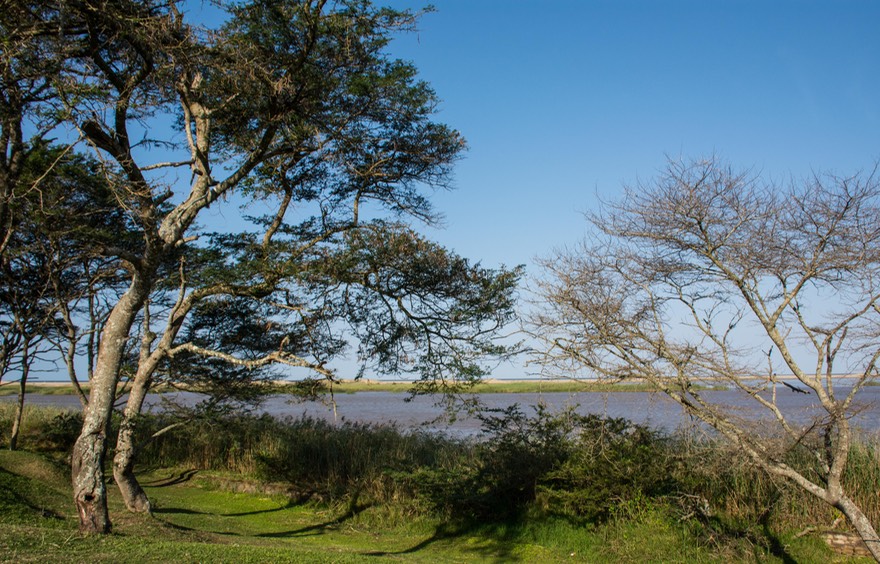
Now we thought we were ready to get on with our adventures…well almost. We figured a good starting place would be at a town up the coast from Durban. It would be in the direction of the places we were heading, but still close to the city if something went really wrong. So on we went to the resort town of Ballito and the Dolphin Holiday Resort. More monkeys, plus palm trees, nice ocean water to dip toes into, tea and scones (“scuns” in the local dialect) every afternoon at 3:30, and a chance to acquaint ourselves with South Africans on holiday.
It would have been easy to stay there forever, but that wasn’t the plan, so after a few days we moved on, hoping to finally leave the city behind and get out into the countryside. We headed for iSimangaliso Wetland Park, the largest wetland area in Africa and a World Heritage Site. It was really neat, and the perfect place to start our adventures. We stayed at a campground in the park… one with a gang of mongoose running around every evening (mongooses? mongeese?… no, apparently it’s mongoose, like “moose”); they were a hoot — African rug rats.
The park is situated around the town of St Lucia (San LOOsha we learned), right on the estuary. We took a boat ride from there early one morning, and communed with hippos and crocodiles. Rick, in a muttered aside, said that the last hippo boat he’d been on had been at Disneyland, and didn’t all hippos wear tutus? The hippo sightings on this boat were really great, with noses and ears poking out of the water in groups and even entire heads with open jaws on occasion. We shared the boat with families from Italy and France and had a great time.
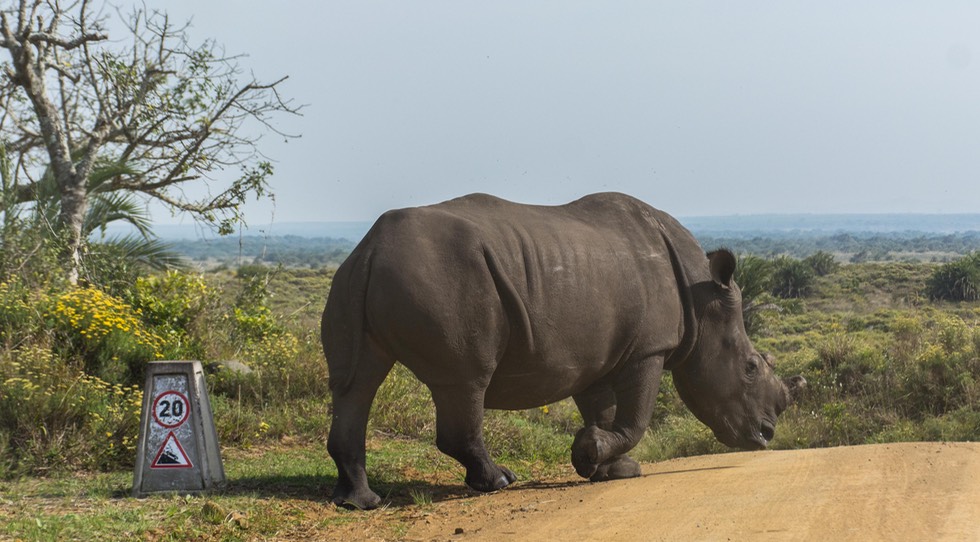
We also took our first game drives and felt as though we’d seen about a zillion critters in the blink of an eye. A slight exaggeration, but right off the bat we had some rhinos on the road right in front of us, lovely zebras, and were busily trying to identify the different kinds of antelope that were all around. We definitely were having a good time.
Our last day in the area we were exploring more of the wetlands, along a small, tight funky little road in the middle of a mangrove forest, when we both got all carried away by the sight of several hippos sleeping on a bank across the way; craack went a tree limb and crash went a solar panel. Sigh. Eleven years and over 340,000 kilometers of travel and this was the first time Rick had damaged the truck on an overhanging obstacle. Drat! Thus began the research on how best to replace a solar panel in South Africa. More on this later.
Undaunted, we carried on. Moving inland a bit, we stopped at a nice lodge which we could use as a base camp while we visited two national parks in the area. Together they are called Hluhluwe-Imfolozi National Park, and the big game experience was excellent, particularly in Imfolozi. We enjoyed wandering around seeing giraffes (they are quite enormous and impressive) and zebras and warthogs and wildebeests, plus buffalo and impala and elephants and rhinos too. Great parks.
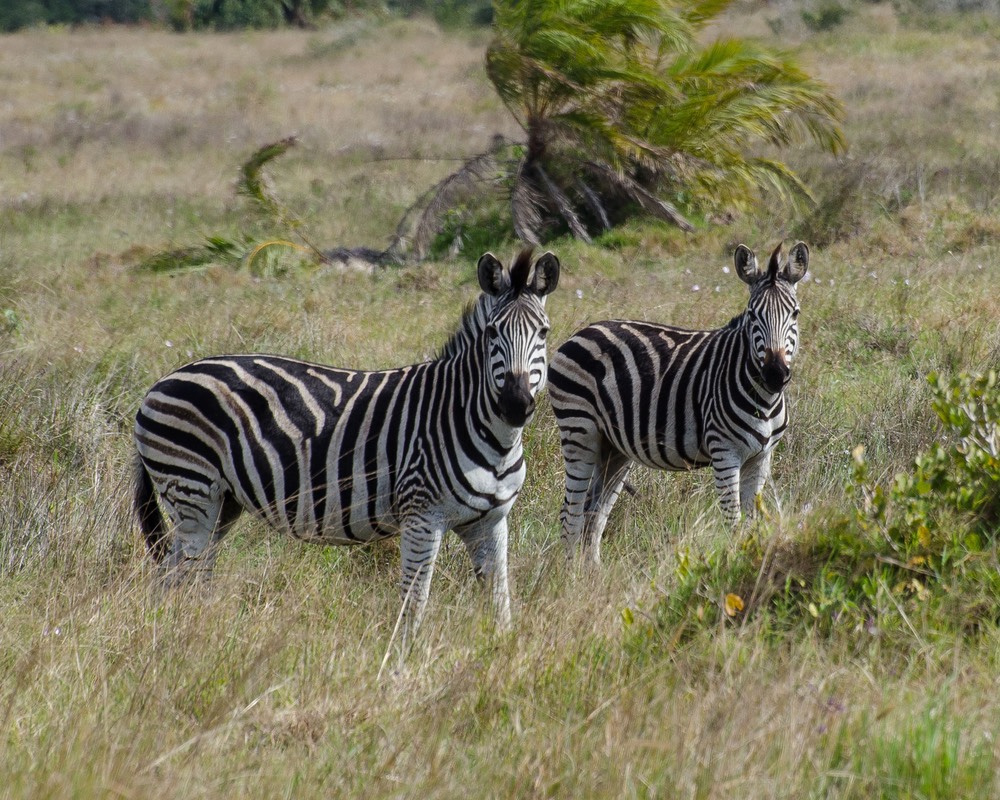
We spent our nights at the nearby Bushbaby Lodge, so named because there are bushbabies on the property — little nocturnal critters that are part of the monkey family. They come out to feed on the offerings left by our host. This is fun! By the way, we want to thank our traveling friends Clive & Ann Barker for the bread crumb trail they left for us here in South Africa. We broke off on our own soon enough, but for the first couple of weeks, from the Bel Aire Hotel through to Bushbaby Lodge, knowing where they had stayed helped ease us into this new environment.
To orient you, we are in the northeastern part of SA. For us, it’s a real return to Central and South America — road chaos, speed bumps/undisciplined drivers/2 lanes becoming 4 by using the shoulder to let people pass — and all this even on the N2, a major highway and sometime toll road! We are also seeing a return to the Full Employment Act — 2 people working and 3 people watching. TIA. This is largely sugar cane country (except for the parks), although there are lots of other crops in the fields as well. It’s a fertile area; there are pineapples for sale along the road, along with tons of avocados and oranges.
In all honesty, it is not a very attractive area right now; we know we are not here at the best time of year. July to September is the end of the dry season and the ground around us is really dry and arid looking. It is also the end of harvest time, so they are burning the grass and the stubble in the fields; unfortunately, the air is terribly smoky most of the time. In areas where the burning has already been done, you can see new grass starting to come in. Perhaps another time we can come back through this region in April or May when we’ve been promised that everything is lush and green.
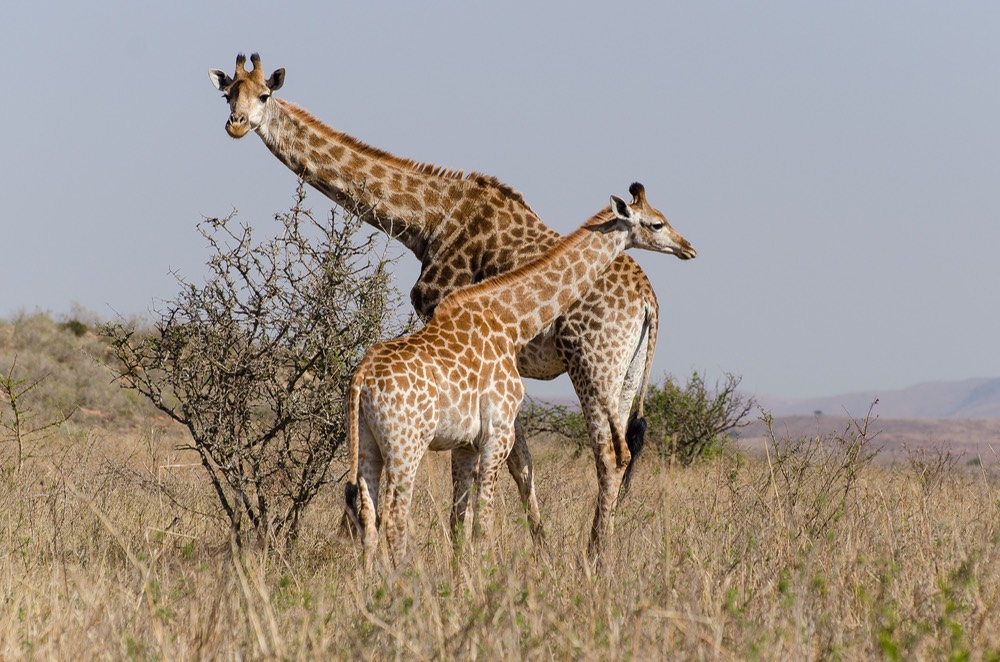
Continuing our hunt for amazing critters, we moved further away from the coast, toward the Ithala Game Reserve, in a more remote, hilly area than we’d seen thus far. It was a nice sunny day after a bit of rain. Along the roadside, we saw burros and cows; no horses yet, but they would come later. Termite mounds, too. Lots of thatched-roof round houses, usually brick or stucco but sometimes made of sticks. Plenty of people walking along the road, some hoping to flag down one of the ever present mini-busses.
We stayed the night in the park and it was great. There was a small dedicated camping area along the river. Small impalas stood nearby, checking us out. Driving through Ithala we saw lots of game, including several rhinos; late in the day a zebra hurriedly crossed the road ahead of us, and then, when we continued, a rhino came moving quickly across the road behind us, missing us but not by much. Nature in action!
This is a lovely, quiet park in a mountainous area. Dramatic vistas, lots of game animals, but remote enough to keep the crowds away. We took a really great 4x4 drive through lovely country. There are lots of elephants in this park, and on arrival we were issued information on etiquette if we had an encounter. Our favorite: “Never allow an elephant to make contact with your vehicle.” This led to great discussions along the lines of, “Wow, really glad they warned us about that, who would have thought.” As it turned out, it never became an issue, although Rick admits to going to sleep with dreams of ordering a special sticker, “This dent caused by an elephant in…”; visualizing just a small dent of course.
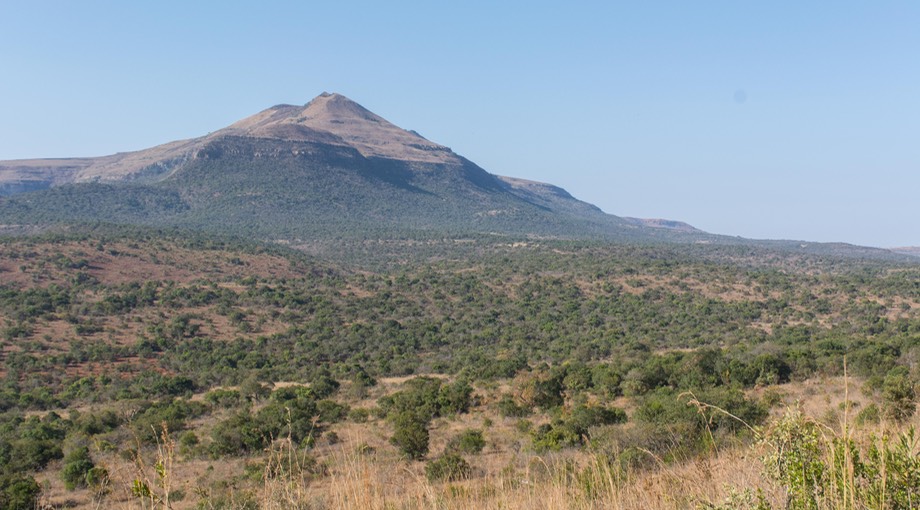
After leaving Ithala, we drove on to the town of Pongola, where we stayed in the municipal campground, which was a bit run-down but serviceable. Pongola is up against the southern edge of Swaziland, where we would be heading shortly. This is an enormous agricultural area with a huge cane mill on the edge of town.
We went in to shop and try to mail a package but the town was very crowded, the Post Office was closed and the ATMs seemed disgruntled. We found out it was a holiday.
Next, we crossed the border into Swaziland, which is a small independent country within the boundaries of South Africa. We had been looking forward to this, our first change of country. No problems, lots of interest in the truck, stamp-stamp on the passports and they sent us on our way. We spent that night parked alongside a lake, staying at the Mhlosinga Rest Camp.
Pigs along the road! Even more like Central America.
We enjoyed several days in Swaziland. There are lovely parks there, one or two sort-of-major cities, and all in a nice mountainous setting. The air was clearer than down at sea level, which we really appreciated.
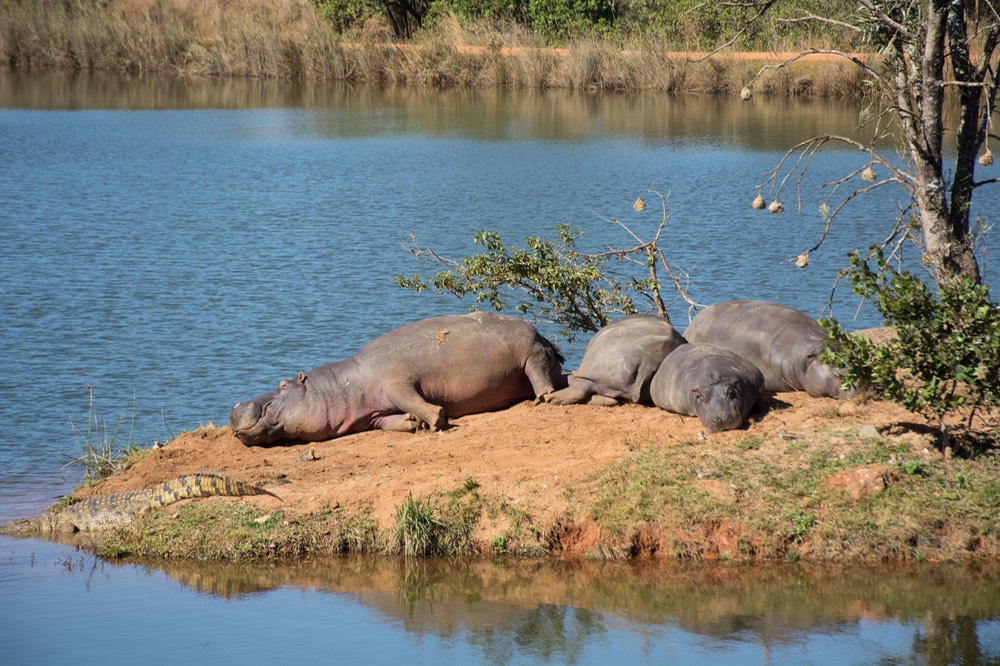
We started out at Mlilwane Wildlife Sanctuary, which we really enjoyed. It’s a private park in a grassy upland area, surrounded by mountains, and quite pretty. There were lots of animals, all fairly tame and free to wander about. You are asked to respect them and leave them alone. Easy to do, particularly the warthogs! There was a family of five that spent a fair amount of time rooting around near our campsite; they were fun to watch, but those snouts mean business.
One of the highlights of Mlilwane is that there are several hiking trails in the park. In almost all game parks, you are not allowed to leave your vehicle except in certain designated spots, and a game drive can leave you feeling very restless and wanting to stretch your legs. So it was great to get out and walk along the trails. Our favorite spot was where the hippos and crocodiles hung out, on an island in the river. The hippos mostly slept in the warm sun, but it was amazing to see them stretched out, piled on top of each other and taking up enormous space, twitching their stubby little feet from time to time. I wonder what hippos dream about?
Mlilwane is a very old park, and there were vestiges of earlier ways of keeping visitors occupied. We found a very old jeep-like vehicle, extremely well used, parked in a spot where it could be closely examined. But more interesting, there was a large display of extremely large skulls sitting on a table. They were identified as being rhinoceros and hippo skulls; we’d never seen anything so huge! Quite impressive.
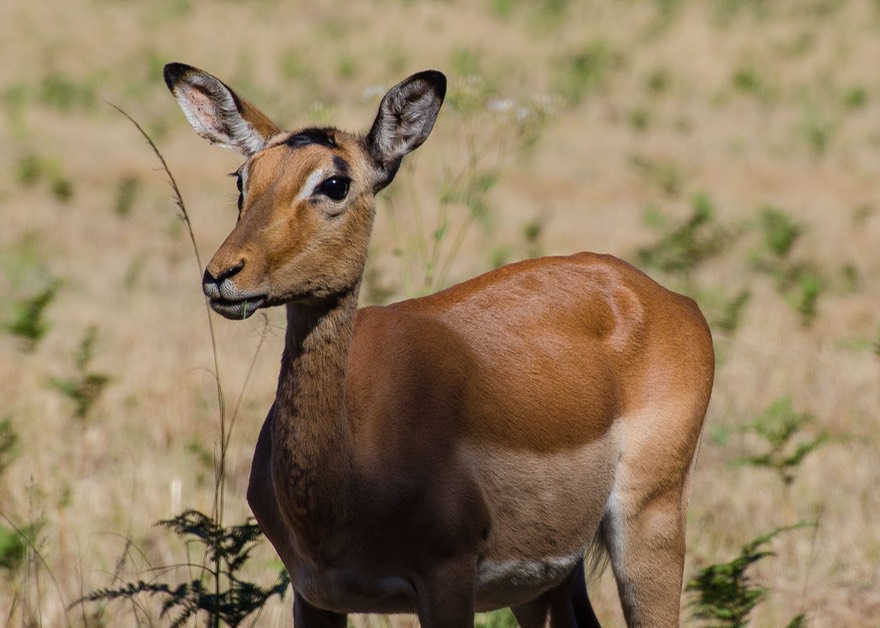
At Mlilwane we met a German couple traveling in a large truck well fitted out for overlanding. Win and Petra are just great, and we had a splendid time getting to know one another. They arrived in South Africa last October and have also spent time in Namibia and Botswana so they were able to share a lot of very helpful information with us. They will soon be leaving their truck and flying back to Germany for several months, but for now they’re moving through the same part of the country that we are, and we parted hoping to see each other again soon.
It’s winter in South Africa, of course, but there are trees and wildflowers in bloom. In this area, they aren’t spectacular, but we enjoy them nonetheless. The most dramatic displays are along the west coast of the country, and we will try to see them at another time. We are seeing lantana, lots of bougainvillea, and many other plants that are very familiar — the climate is quite similar to that in California. It’s all rather pretty, now that we’re away from the sugar cane.
Leaving Mlilwane, we saw a sign that the park’s patron was His Majesty King Mswati III, the current ruler. We waved a big thank you in passing.
Climbing higher into the mountains to get to our next destination, we topped out at 1525 meters. Much of the countryside is pretty bare, but where there are trees it’s quite attractive. Leaving the urban area, we turned off the highway onto King Mswati II Highway (III’s father — see above), heading towards Malolotja Nature Reserve. When we arrived we were happy to discover that Win and Petra were also camped there, and we enjoyed some more time together.
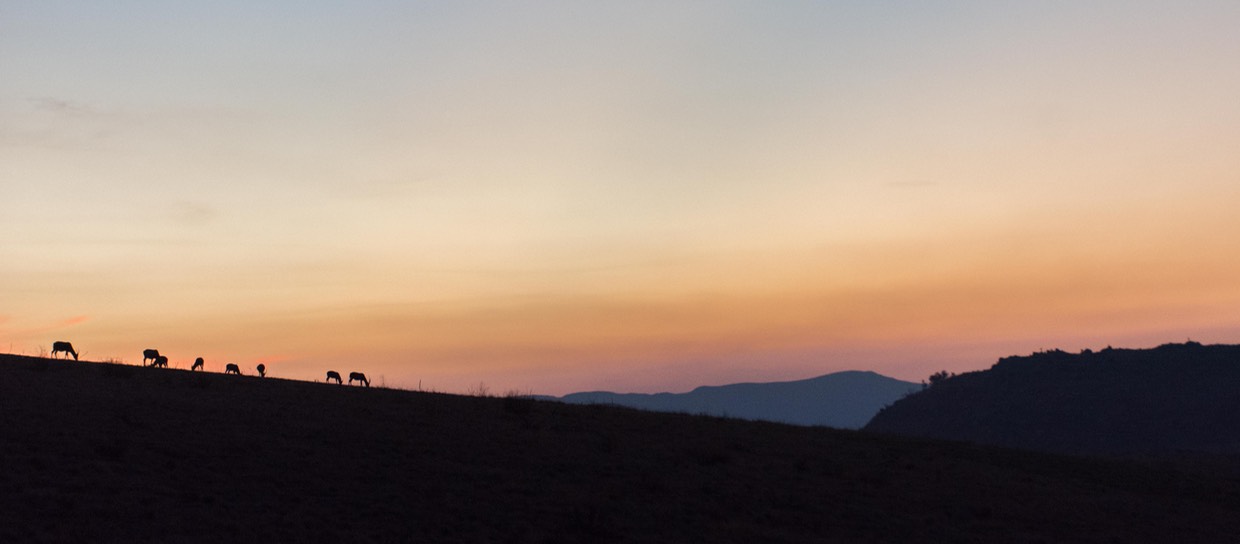
We were on a lovely quiet mountaintop; the park has excellent staff and facilities and we were delighted. Blesbok, impalas, wildebeest, zebras; we would have enjoyed staying longer, but decided to move on. Heading out of the park we dropped about 1000 meters to cross a dam and then climbed up again towards the town of Pigg’s Peak where a guy named Pigg — what else — had discovered gold back in 1884. It was too smoky to enjoy the views as we climbed, and very dry, but it would be a lovely mountainous area another time.
At Pigg’s Peak we turned west onto a dirt road that takes you to the border with SA through a combination of managed forest and clear-cut areas; just 4 kms out of town you enter private forestry property and onto 20ks of the most atrocious road ever, just to get to the border. We survived. Crossing the border back into South Africa was quick and easy and suddenly we had pavement again. And a newly planted forest. As we dropped down the mountainside, we drove through a series of recently completed pullouts featuring the ever-changing layers of geology and exposed rock, with information boards and lovely viewpoints. It was quite impressive. At the top of the mountain we had been at 1560 meters (just over 5,000 feet).
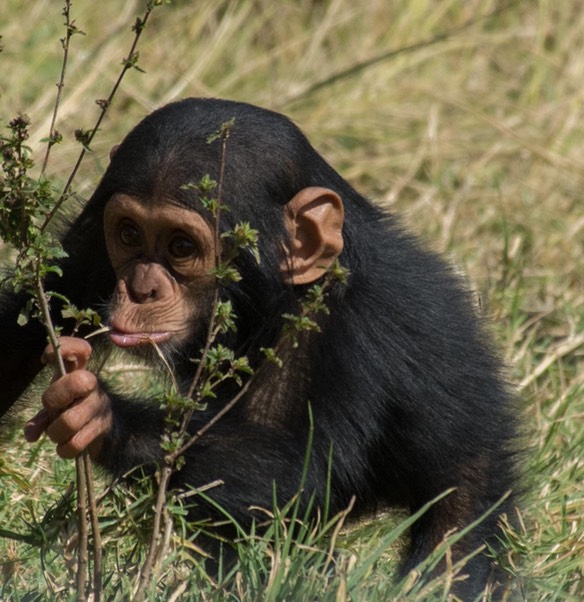
We dropped straight down to the city of Barberton, at 815 meters. At this lower elevation all the trees are in bloom, with bougainvillea and flame trees everywhere. We had intended to stay at the municipal campground, but in the waning daylight we kept driving around this big construction site where our GPS told us the park should be. We finally found the “entrance” — a large hole in the ground. Seems the park is going to be a grand hotel. Good for the city, but bad for us. Where to spend the night? Chatting with the locals, they suggested we just head over to the police station, which had a large parking area. We did, they were fine with it, and we had a quiet, comfortable night.
The next day, after reorganizing ourselves and doing some shopping, we were off to see the Chimps at nearby Chimp Eden, more formally known as The Jane Goodall Institute. This is a small rescue center, started by Jane Goodall some years ago, for chimpanzees that had been rescued from a harmful environment.
We had a special reason to visit, as friends of ours who used to live in Africa had rescued a chimp (Ba’timbe, aka Claude) who was now living here. They had suggested we stop by. As it turns out, Claude was not on view, as he was with a group that lives off by itself. But there were plenty of them to enjoy, including a baby (a surprise to the staff as this is not a breeding facility!) that had suddenly appeared a few months back. We had a really good visit there, and left with a greater understanding of how the animals interact with each other, with humans… and how amazingly similar they are to us.
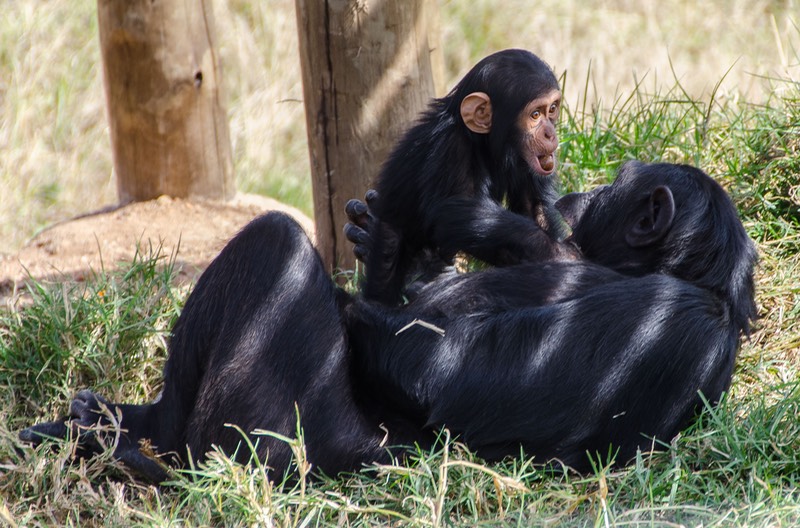
But on to Nelspruit, a regional center that seemed to have every store imaginable. We took care of some business, bought some new maps, shopped for things we’d not seen in quite a bit, including some headlight bulbs for the truck, and asked in a butcher shop why we couldn’t find any freshly sliced ham (“we just don’t do that any more”). Then we headed west a few kilometers past orange groves full of ripe fruit, to the aptly named Hippo Waterfront Lodge, a lively and lovely campground where we parked ourselves for a few days. Win and Petra had said they would be stopping there and we were delighted to find them still in place. They, along with others who came and went, added much pleasure to our visit. So did the resident vervet monkeys.
This is a great stop for overlanders. We met Colleen and Jim from Idaho, who remarkably enough come from the same small town, Hailey, as other traveling friends of ours — and even know them — and more Germans, Jürgen and Birgit. Hippos played in the water and Rick washed the truck so we could apply our yellow reflective tape along the sides. We did this because it’s a requirement in some countries for vehicles over six meters long, but we think Tiger looks rather dashing in his new regalia.
Getting quite warm now. After leaving our riverside spot we went back into Nelspruit to shop and recharge our SIM card, then on to a park just west of town that is beside a small lake, settling there for a couple of days. There were a number of permanent residents in the park, and they were both curious and friendly. So far we like the locals.
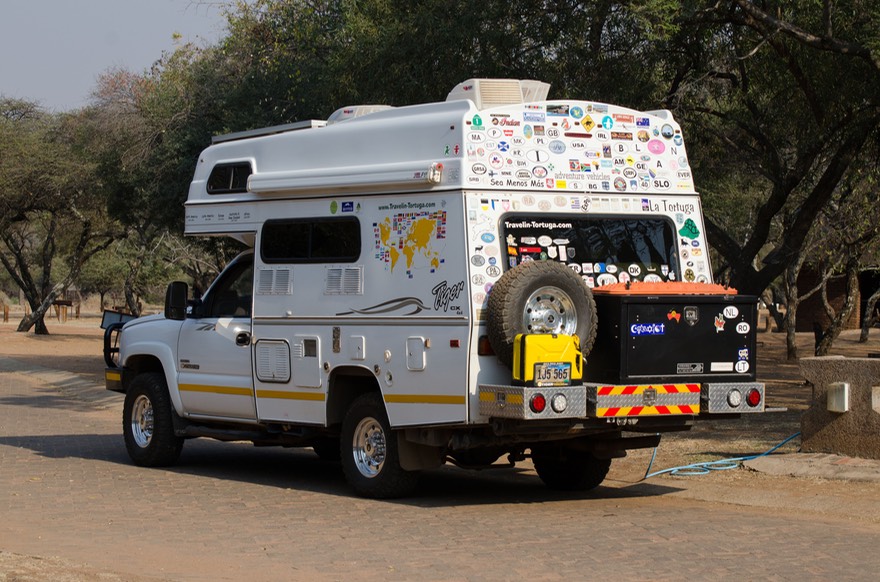
On Sunday we traveled west across about 200 kms of South Africa to Pretoria for a Monday appointment to get the whacked solar panel taken care of. The first part of the trip was quite nice, along a small quiet road that went up over a pass and through an area very popular with wild horses; then we joined the toll road, which immediately became quite boring. As we came closer to Pretoria, the cars got fancier, the people drove faster, the freeway got more modern; as ever, ya coulda been anywhere!
Our meeting with the solar guy turned out to be a really good experience. We’d found him through an online connection and when we made the appointment asked if it would be possible for us to spend Sunday night at the site; yes, of course. But more than that, Jakes and his wife Ina welcomed us into their home/work compound, fed us good food, insisted we sleep in the house, and taught us a lot about life here, both the good and the bad. We now consider them good friends and will hope to see them again.
The work ended up taking all day, so we were urged to spend a second night, and then the following day Jakes (Jacob) accompanied us into Pretoria to show us some of the sights. It was great fun, and we were joined by Wilson, Jakes second in command, so we were a gang of four.
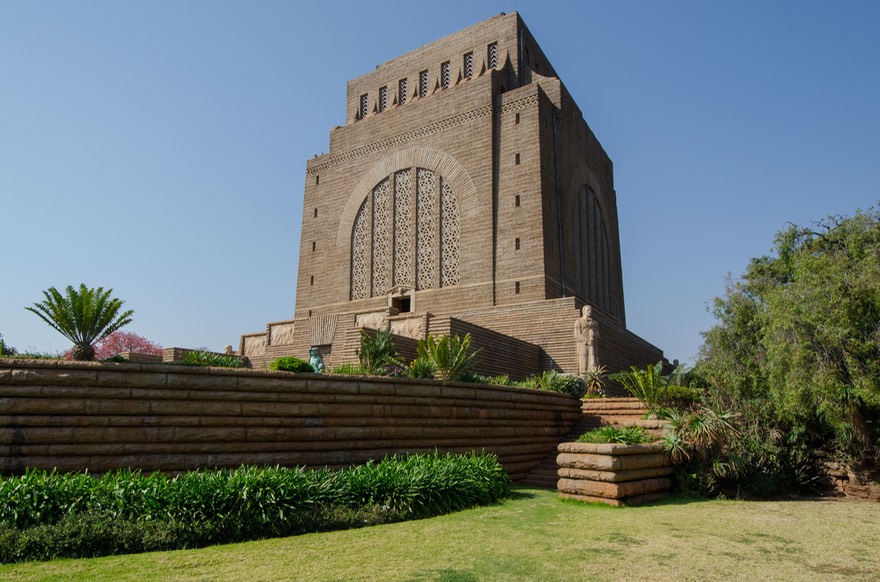
We started at the enormous and very interesting Voorstrekker Monument atop one of the hills of Pretoria, both a monument to the early settlers of South Africa’s interior, and a museum filled with lots of memorabilia and historic material. It was quite impressive and went a long way toward filling in some of the historic gaps we carry around. In modern times the entire edifice is considered very non-PC, and there is talk of tearing it town. A rough equivalent might be the Confederate memorials that are common in the American south and under the gun to be destroyed.
The other attraction that Jakes didn’t want us to miss is called the Union Buildings. This is the seat of government for the country and the presidential offices are here. The lovely buildings are atop a hill in a park that is very popular for political demonstrations. When we were there a strident voice was explaining the very important reasons why a certain something needed to happen — and had a significant crowd in attendance. There is an enormous statue of Nelson Mandela facing out to the open area, and you do indeed feel his presence.
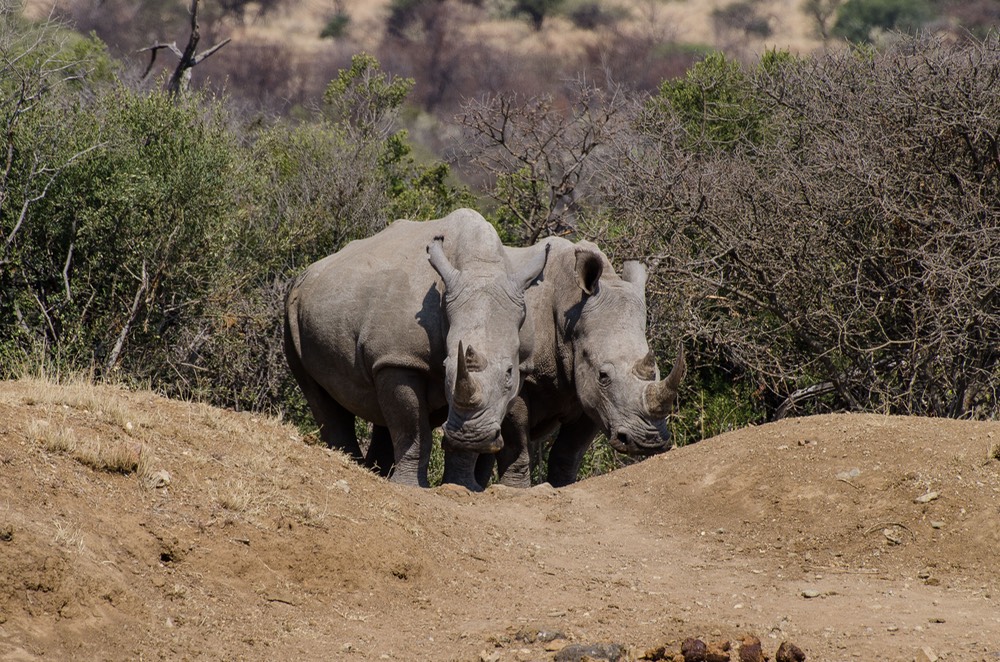
Sufficiently worn out after all this, we said good-by to Jakes and Wilson, and started west from Pretoria, heading for Pilanesberg National Park, which we’d been promised would show us a very good time. And boy, it sure did. We ended up staying two full days, one to see all the animals, as well as an excellent Iron Age settlement site, the other to recuperate afterward and catch up on some work to be done.
Pilanesberg is where the story about the elephants with which we began our tale occurred. It really is a nice place and we saw plenty of animals in a very natural setting. They say the park has 200 kilometers of roads for game viewing. We couldn’t see it all, but in a very full day we did manage about 80 kms, mostly dirt, which took us up and down in elevation from flat lands to more mountainous terrain. We encountered a group of hippos down by the lake, rhinoceroses two different times, giraffes, zebras, large groups of several types of antelope, and the aforementioned incredible elephant sighting.
This was by far the largest group of elephants we’ve yet seen, probably about two dozen or so including several youngsters. They had an obvious leader and tail gunner making sure everyone stayed together, and were very purposeful. They moved right down to the water where everyone had a good drink and then went off into the bush again in very good order — no splashing or playing around. When we first saw them, as we were leaving the hide, we didn’t know where they were headed; we moved cautiously down the road in their direction. We weren’t ever all that close, but could see them through the bush. After they had all passed by we were able to pull into a loop turnaround overlooking the spot where they were gathering along the other side of the waterhole. It was a great moment for us and a real highlight of our day in Pilanesberg.
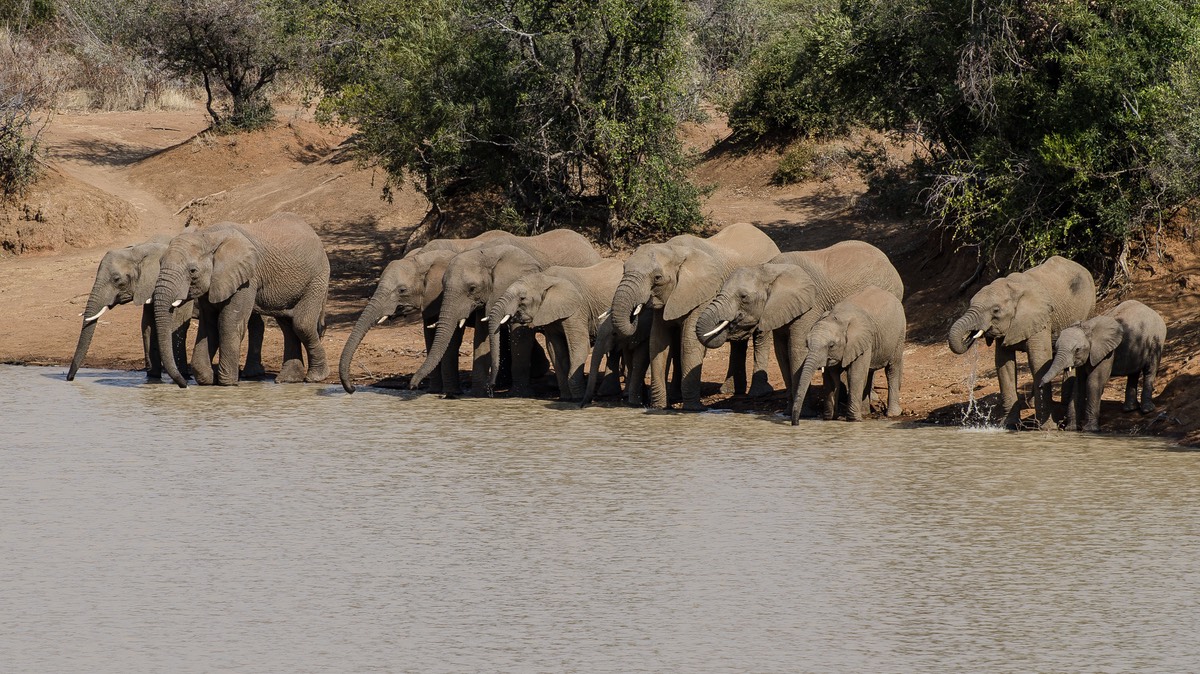
We are now getting closer to the day when we are scheduled to arrive in Kruger National Park, in the far northeastern corner of the country, so we’ve begun moving in that direction. No problem; there are several things we want to see along the way, and we also have things we hope to do before entering the park. We don’t like to book ahead, but with a place as highly regarded and popular as Kruger, you pretty much have to. We’ve booked eight nights in the park based on the recommendations of several other travelers. It may or may not be enough, but we know it will at least make a good start.
Beyond Kruger, well, as usual we don’t really know. We’ll still have about six weeks left in our first 90 day visit to South Africa and there’s still a lot to see. We’ll let you know what we end up doing when next we write.
For now, Sala Kahle from the two of us and our ever faithful La Tortuga, complete with new yellow stripes… and a few pictures of turtles to enjoy.
On the Photo Page for this story you will find more than 200 animal pictures